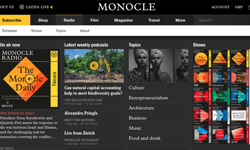Much as I've come to loathe the buzz words "disruption" and "reinvention", they do capture some of the profundity of the change underway. And as traditional print advertising and circulation revenue streams increasingly come under siege, the pace and scope of the leading companies' diversification strategies are accelerating and expanding.
Not surprisingly, given its circumstances, Time Inc is proving the most aggressive. Burdened by $3.1 billion in net debt and the pressing needs to woo cutting-edge-obsessed investors and create new revenue streams, it is, as Business Insider recently pointed out, no longer merely working to embrace or keep up with new media platforms and channels; it's actually attempting to become a tech company that invents these.
Indeed, for all of the shock waves generated by the most widely covered developments at Time Inc in 2014 - cutting 500 jobs; having editors report to the business side; embracing "native" advertising; putting ads on some print magazine covers; evaluating some digital writers in part on whether their content "benefits advertiser relationships"; drawing hard lines in negotiating with the writers' and editors' union as it prepares to outsource some editorial work to cheaper and more malleable offshore content generators - the reality is that CEO Joe Ripp was from Day One unusually frank about his direction.
He made no bones about his conviction that it would be foolhardy to let traditions of any kind, including "church / state" separation, impede rapid progress toward his vision of a transformed - and therefore financially viable - company.
Nor should anyone who grasps the underlying dynamics have been surprised by the December announcement that Time and People magazines are reducing their print circulation rate base guarantees as of this year. More of the same (and not just at Time Inc) can be expected in the months ahead, now that the foundation has been laid by the MPA's introduction of Magazine Media 360° - reports on metrics that aggregate print audience, unique website visitors (desktop, laptop and mobile) and unique video views for about 150 (mainly large-company), MPA-member "media brands". These are being supplemented by new reports tracking followers and "likes" for magazine brands across Twitter, Facebook and other big social media networks.
Level playing field?
The new metrics seek to put magazine brands on more equal footing in competing with other media for advertising. They also provided a convenient rationale for eliminating the longstanding PIB print ad-page count reports - and thus those pesky trade media reports about the negative trends in these counts. Further, publishers hope that the audience metrics will be a big step toward realising their long-held dream of getting advertisers, media buyers and the press to let go of circulation numbers and audit reports, which were viewed as competitive liabilities and albatrosses around their necks even before newsstand declines accelerated, and even before they could make the argument that digital media and their cross-platform reach have made print circulation numbers and makeup irrelevant. (The argument: With millions of "uniques" and "likes" to offer, why should magazine brands, unlike pure-play digital publishers and other media, also have to report circulation minutiae? Eat this, not that.)
No, folks, the real surprises are yet to come. At Time Inc, all of the moves to date have been clearing the way and setting the stage for the types of tech initiatives now beginning to unfold.
As BI points out, in just a few weeks at the end of 2014, Time Inc became the first magazine publisher to accept Bitcoin for subscription payments. It also launched a People en Espanol online show, and a People partnership with "consumer intelligence" company Poshly to create a co-branded, data-driven digital channel offering fashion and beauty giveaways.
Even more eye-opening, it launched a partnership with the online service IFTTT (If This, Then That). Its five leading weeklies will now have IFTTT channels, and in BI's description, Time Inc will use an "internally developed OneBot social trending tool, so IFTTT users will receive links to trending stories with customised notifications… If they follow the channels, they will receive curated weekly email digests and articles can be pushed (if they choose) to Twitter and Facebook, or to apps like Pocket, for reading at a later date."
In a nutshell, Time Inc no longer wants to be surprised by new platforms; it believes it can get ahead of the curve, take control of its destiny and become a disruptor itself.
"We’ve got to stop thinking about the older, traditional, write an article, sell ads [type of model]," Time Inc SVP of digital M Scott Havens told BI. "We are building other apps. We are trying to think about non-text-based journalism features [and] other [standalone] apps and businesses. [In 2015], you will see lots of stuff coming out of Time Inc that people are not used to seeing from us.”
While not (so far) saying that they aspire to becoming tech companies per se, Hearst, Condé Nast, Meredith and other magazine media companies are, as noted, also pushing into all kinds of new territory - mostly through partnerships with other media powers and acquiring emerging tech companies. More on all of that in the year ahead…












